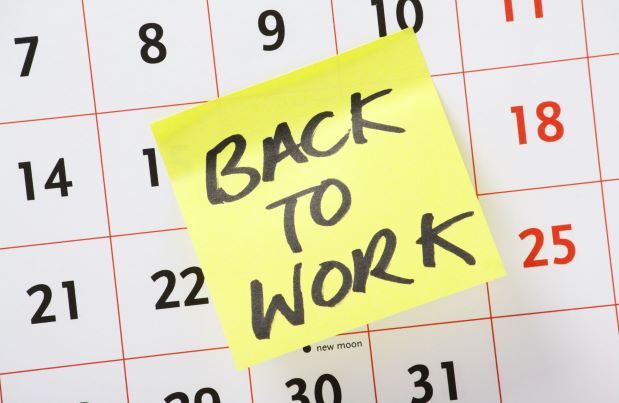The workplace has been transformed as a result of Covid-19. Employers must balance new requirements, staffing changes, safety and hygiene concerns, and managing their operations, all while avoiding management missteps and liability. Now that some or all of the workforce is returning, it is more important than ever to act strategically.
Have a Plan! And Be Willing to Amend It
Pursuant to the Occupational Safety and Health Act (“OSHA”), all employers have a legal duty to maintain a “hazard-free workplace,” and if employers are voluntarily exposing employees to hazards in violation of published guidance, they are at risk for infected employees as well as litigation. On May 7, 2020, the California Occupational Safety and Health Administration issued Covid-19 Industry Guidance – Office Workspaces which includes comprehensive guidance and steps to take as employees return to the workplace.
We recommend that all employers become familiar with the OSHA guidance. Below we touch on some of that guidance as well as provide a checklist and other key strategies for employers. Overall, employers should be flexible, recognize when certain strategies are not working, and be willing to adjust.
First, employers should continue the key prevention strategies which most everyone is already familiar with: maintain physical distancing to the maximum extent possible; provide/facilitate use of face coverings for employees and customers/clients; and implement frequent handwashing and regular cleaning and disinfection. There a number of other measures that employers should be prepared to take:
- Prepare a worksite-specific COVID-19 prevention plan that includes a risk assessment of all work areas, and a designated person at each location to implement that plan. Train employees on the plan.
- Develop an exposure-response plan that addresses: isolation, containment and contact tracking procedures; stay-at-home requirements; and exposure communications to affected staff.
- Provide personal protective equipment (PPE) such as: masks, gloves, face shields, etc., and personal hand sanitizer.
- Detail cleaning procedures and procure supplies.
- Establish physical distancing measures within the workplace, such as staggered shifts and lunch/rest breaks; rotate weeks in the office and working remotely; move workstations to increase separation distance; implement one-way traffic patterns throughout workplace.
- Consider staggered and/or voluntary returns — welcome back a smaller “test group” of employees. If feasible, let employees choose their return date out of several staggered return dates.
- Restrict business travel: start with essential travel only and define what that is. Follow government guidance to ease restrictions over time.
- Define customer and/or visitor contact protocols such as: directing customer traffic through workplace, limiting the number of customers in any area at one time, no handshake greetings, using video or telephone conferencing instead of in-person client meetings, and providing contactless pickup and delivery of products.
- Be aware of how the workers’ compensation framework might interact with workplace Covid-19 infection. Worker’s compensation will usually pre-empt claims by an employee for injury at work, but there are exceptions to this, such as if the employer is grossly negligent.
Employee Screening Dos and Don’ts
YOU MAY: take employee temperatures at work. Temperature checks should be reliable, performed consistently, and respect employees’ privacy. All employees entering facilities should be checked only by trained personnel and the results should be treated as confidential.
YOU MAY ASK: employees if they have tested positive for or been diagnosed with Covid-19, if they have symptoms of Covid-19, e.g., fever of or over 100.4, cough, shortness of breath, sore throat, or loss of taste or smell; if they have had close contact with any person who has tested positive for, or has otherwise been diagnosed with, COVID-19 infection in the past 14 days; if they have been asked to self-quarantine by a health official within the past 14 days; and whether they have traveled to, or stopped over in, a country for which the CDC has issued a Level 3 travel health notice.
YOU MAY NOT ASK: if the employee has any underlying health condition that would make them more vulnerable if infected by Covid-19. This would be a violation of their privacy. If you do ask such a question, any employment decision you later make about that employee could be scrutinized as potentially discriminatory, based on the employee’s disability, or the employer’s perception of the employee as having a disability.
If an employee has tested positive for Covid-19, there are key steps you should take immediately. These relate to the employee as well as to all others who may have been exposed. Duggan Law is available to help guide you through this process.
Consider Handbook or Policy Changes
We are not back to business as usual. Employers will likely need to update or create policies to reflect our new reality, including some of the following:
- Paid-leave policies adjusted to reflect new requirements and actual business needs.
- Attendance policies relaxed to encourage sick employees to stay home.
- Time-off request procedures clarified to indicate when time off can be required by the employer, should sick employees need to be send home.
- Flexible scheduling options implemented allowing for compressed workweeks and flexible start and stop times.
- Meal and rest break policies adjusted to stagger times and processes implemented to encourage physical distancing.
- Telecommuting policies detailed to reflect the type of work that is able to be done remotely and the procedure for requesting telework.
- Information technology policies revised to reflect remote work hardware, software, support, and employee reimbursements.
Avoid the Appearance of Bias in Employment Decisions
If your workforce returns in waves, do not allow younger employees, or employees without chronic underlying conditions, to return first. This could expose you to an age or disability discrimination suit, even if your intention was to protect your vulnerable employees. Also, beware of the potential disparate impact that your decisions could have. If the first work unit you welcome back consists solely of employees under 40, and there are older employees in other departments still at home, you could be exposed to liability for the discriminatory impact of that decision, even if it had nothing to do with age. Do not retaliate against your employees for taking Covid-19 protected leave, or because they might need extra leave in the future. For example, do not decide not to re-hire an employee because she has significant caretaking obligations due to Covid-19. In short, ensure that you have a legitimate and non-discriminatory reason for every employment decision. You may wish to test your reason by determining if you can articulate it in a way that you would not mind saying out loud in front of a jury. Finally, ensure you have documented the reasons for your decisions.
Be Reasonable: Addressing the Challenge of “Reasonable Accommodations” in the Post-Work-From-Home Era
Undoubtedly, some employees will request continue working remotely while their employers require them to return. Employers will need to address morale issues and anxiety from reluctant employees. Our “new normal” will impact the interactive process when employees seek reasonable accommodations, whether those accommodations are related to Covid-19 or not. It may be more difficult for an employer to claim that remote work is an “undue hardship” when an entire company has operated remotely for many months. It may also be even more difficult to successfully claim that one or two days per week at home is unreasonable. However, this does not mean that employers must automatically allow remote work. We have been working remotely by law and necessity. The fact that remote work was a “reasonable accommodation” in April 2020 does not necessarily mean it will be reasonable six months later.
Still, you must engage in the interactive process in response to an accommodation request. If your employee has “anxiety” about returning to work due to Covid-19, does that constitute a disability under the Americans with Disability Act or the Fair Employment and Housing Act? The short answer is: maybe. If you or your counsel determine that it is likely a covered disability, an obvious accommodation is that the employee be permitted to remain at home. However, what if it would be very difficult to run your business without this person in the office – can you claim “undue hardship”? Depending on the circumstances, you may well be able to. Still, if you terminate an employee because they refuse to work from home, you may be inviting a discrimination or retaliation lawsuit, even if you were “right.” Experienced employment counsel can provide creative but practical solutions to help the savvy employer avoid costly disputes.

